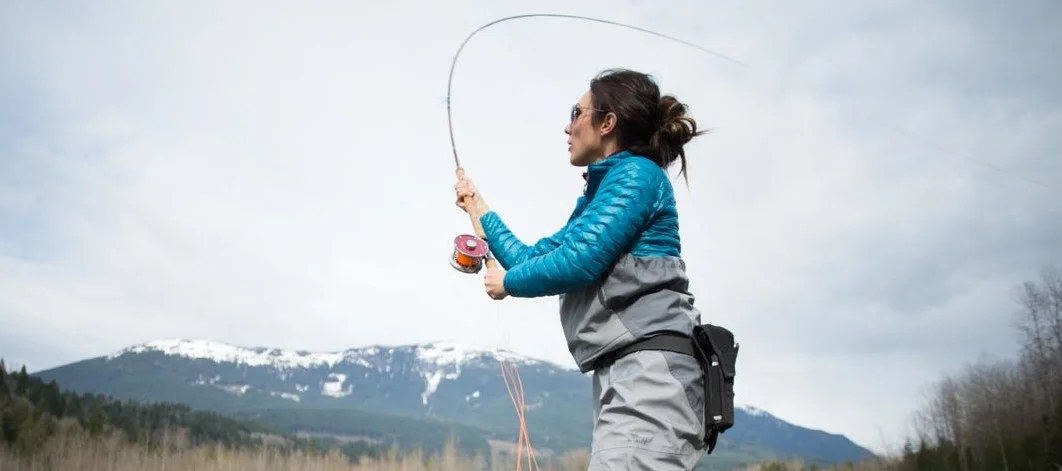It’s a new age, a new generation and a new very distinct dividing line that is being drawn between the ways of the past and the ways of the present.

This dividing line cuts deep, driving the mavericks and the leaders of this generation to proceed in paving new paths; more specifically to the fishing industry, paths that are being paved quite literally to the river.
Needless to say, this path is not welcomed openly by all.
This is always an interesting topic of discussion for me.
You see, the truth is that I have listened to many an angler share their story and I have been blessed with the good fortune to meet some incredibly knowledgeable people who have spent the majority of their days of existence on the water.
From the industry’s old guard of anglers who built the sport’s foundation, to the industry’s “new school” of anglers who continue to add renovated extensions to this existing structure, I am always fascinated by the tales and opinions that I am told.
As should be expected, varying personalities result in varying opinions and while there are some who view this dividing line as growth, there are others who view it as counter-productive (an “if it ain’t broke then why fix it?” viewpoint).
Personally, not one to call myself traditional, I admittedly embrace any form of “new” mentality ‘outside the box’, whilst moving forward and onward towards diversity and whatever other innovations I may be privy to exploring within myself as an angler.
This can of worms that I am about to open has many related areas of controversy that a 2,000 word column can’t support, so while we could fill half of this post with the changes and debates of “old vs. new” from a media standpoint, I am choosing only to focus on one of the branches of this topic: what is the difference between the flies developed and improved by each of these generations?
Fly-fishing for steelhead in BC began to gain popularity and momentum in the early 1900’s when legendary writers and anglers like Roderick Haig-Brown began exploring steelhead opportunities on the coasts of Canada and the USA. A true pioneer of the sport, it is said that Haig-Brown fished like he wrote: with elegance, admiration and respect for the fish that he longed for.
The Haig-Brown days started an angling revolution of deer and mallard clad flies, silk fly lines and traditional presentations for non-pressured fish. A myriad of anglers found themselves touched by the poetry of the sport and a romance soon blossomed amidst man and the blushed cheeked beauties we call steelhead.
Simplicity graced the equipment, the rivers and the anglers themselves. Conservation mayhem had not yet encompassed entire fisheries and angling pressure simply didn’t exist.
Similar to the traditional methods of Atlantic salmon anglers, flies were sparse and delicate, sink tips were virtually unheard of, and long bellied lines were the only method of fly delivery.
I have always had a soft spot for the classic tiers and steelheaders from before my time.
To have seen the things that they must have seen, walked the shores that they had walked, unraveled the mystery of the elusive steelhead with the truest of virgin eyes. As a girl, I would fantasize and toy with the idea that my very steps were falling within the outline of Mr. Haig-Brown and such legends. A walk to a river that may well have once been the first of a fly-fisher set out on a mission to find a traveled steelhead.
A river never touched by a line, crossed by a wader-clad human being or disrupted by a stripped streamer; I was enamoured by the possibility that I may well have been experiencing the exact moments of anticipation that those before me had felt. Fishing seemed simple then.
It was inevitable that the techniques of the early 1900’s would transition and begin to take the form of alternate methods.
In the early 1990’s, a small group of anglers on the West Coast of the USA, including the likes of Ed Ward, Mike Kinney, Mike McCune, and Scott O’Donnell, developed a fly line known as the “Skagit” line. More similar to that of a 26 foot long, condensed grain shooting head ideal for double-handed fly rods, these lines enabled anglers to turn over larger profiled/weighted flies, as well as heavy sink tips in various lengths.
These adaptations were a relief, as more anglers were able to effectively fish entirely new depths in the water column, thus enabling them to present more obnoxious flies to less active winter steelhead that often needed extra “assistance” with their aggression.
With the ability to cast heavier flies, came an explosion of articulated bunny leeches and elongated streamer patterns. Bright colors and creative materials made their way to the river as steelheaders from around the world sought tying therapy by delving into their creative energies at tying desks in an attempt to craft an ultra-effective steelhead fly.
With shorter lines, easier casts, interchangeable sink tips and “no need to follow the recipe” flies, steelhead fishing has become appealing to even the most inexperienced of fly anglers.
Fishing is “simple” now.
There are some traditional anglers who scoff at the flies and technique born of this revolution.
Justifiably, such naysayers are soon met by an explanation that an influx of angling pressure combined with the misfortune of fewer fish, has forced anglers to think a little differently.
The reality of it all is that both traditions, old and new, have proven to be astonishingly effective.
One of the major hang-ups that I have encountered as a fly-tier is the perceived drastic difference in patterns stemming from the old and new ways. It had always been my impression that the older style of flies seemed to be tied with more neutral colors and a smaller profile. In stark contrast, I have found that many of the more modern steelhead flies tend to be brighter and larger in both length and profile.
While I understand that the majority of these more recent flies are designed to be swung through the current, many of the flies of “yesterday” were also designed for such a presentation as well.
It was inevitable that I would finally reach out to the men that I have followed and learned from, to ask them myself: “What is your favorite winter steelhead fly pattern?”
I reached out to eight different tiers, each of them renowned as fly-fishermen and dedicated long-time steelheaders. I put serious thought into each before I contacted them, and set out to find one expert from each of the listed categories.
Traditional:
Canada West Coast, Canada East Coast, USA West Coast, USA East Coast.
Modern:
Canada West Coast, Canada East Coast, USA West Coast, USA East Coast.
I didn’t really know what to expect.
Would these flies be ultra-traditional, complete with gut eyes and tented wings, or would they have adopted some of the more recent characteristics of stinger hooks and other tricks?
I didn’t have to wonder long as their photos and flies poured in and I was able to come to a conclusion myself…
The end result being that I was astounded by the similarities between patterns. From the West to the East, and from then to now, despite distinct differences, there were equally as many similarities.
Each fly had related characteristics. While the more seasoned tiers tended to down-size their flies, most of them let me know that they also tied and fished their trusted patterns with an articulated and extended trailing hook. This method not only allows the angler to replace dull or bent out hooks with new ones, but it also allows for an extra amount of security while fighting fish.
The use of a trailing hook was not the only major characteristic these flies shared. Their profiles and colors shared definite likenesses as well.
Each fly was designed for classic swinging water and each fly was tied to maintain a profile as it danced and flickered through the current.
The differences that I noted were surprisingly few, but all of the differences that I observed came in the form of either size, weight, or use of flash.The newer flies seemed to hold more size, often included weighted eyes, and had an abundance of flash or tinsel. Bigger, bolder, brighter… like a steroid infused traditional pattern, the newer flies simply demanded the attention of any finned passer-by’s.
There are reasons and stories behind every innovation.
The men before us once sparked creation from their inspirations: a ribboning leech through an early morning pond, a Coho Blue pattern found on a coastal stream bank, an idea sparked from a late-night tying session with the guys…
Just as they have built from theirs, our new generation seeks inspiration and creates as well: an injured bait fish gasping in the shallows, a photo of a Combs’ classic or perhaps a pattern in the bin of a fly shop…
Both “old” and “new” walk the same line of creation and artistry.
So while it is true, the times are changing, it is the perceived dividing line that finds itself reshaped and morphed into a full circle. One where the “new” comes back to the old, and the old revisits the “new”.
They both meet in the middle and they both evolve as one; dependent on one another to move ahead.
Traditional:
Canada West Coast- Art Lingren
Canada East Coast- Larry Mellors
USA West Coast- Trey Combs
USA East Coast- Ray Schmidt
Modern:
Canada West Coast- Sky Richard
Canada East Coast- Paul Castellano
USA West Coast- Scott Howell
USA East Coast- Kevin Feenstra






















